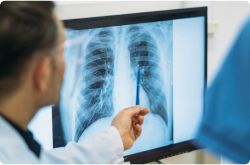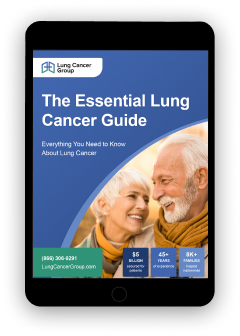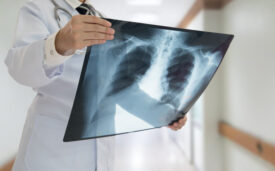Lung Cancer
Lung cancer is the second-most common type of cancer in the United States. You could develop lung cancer if you smoked or were exposed to other cancer-causing substances like asbestos. We’re here to help you better understand your lung cancer diagnosis, review treatment options, and explore financial compensation options to cover any expenses.
What Is Lung Cancer?

Lung cancer forms when cells in lung tissue mutate and divide at out-of-control rates. The cancerous cells form tumors that can overwhelm your body. Smoking is the main cause of lung cancer, but asbestos exposure and other toxins can also put you at risk.
While lung cancer is very aggressive, it may be possible for you to live a long time with it. Doctors can recommend different treatments to destroy cancer tumors to boost your odds of living longer.
Lung Cancer Quick Facts
- Rates: Lung cancer is very common, with roughly 226,650 people estimated to develop lung cancer in 2025, according to the American Cancer Society (ACS).
- Symptoms: Common lung cancer symptoms include coughing, shortness of breath, and chest pain.
- Types: Non-small cell lung cancer (NSCLC) and small cell lung cancer (SCLC) are the two main types. NSCLC generally has a better health outlook.
- Treatments: You may potentially be able to beat lung cancer with treatments like surgery, chemotherapy, immunotherapy, and radiation.
- Survival: Lung cancer life expectancy ranges from 8-23 months, but some patients live for decades.
Lung Cancer Group can walk with you through every step of your lung cancer journey. A diagnosis can be overwhelming, but we’ll help you understand what to expect and how to receive the care you need.
Get our Free Lung Cancer Guide to see all the ways we can assist you or someone you love.

- Understand risk factors
- Find top treatments
- Pursue compensation




Causes of Lung Cancer
There are several possible causes of lung cancer, most notably cigarette smoke and asbestos exposure. Learn about common lung cancer causes below.
Smoking
Smoking is the main cause of lung cancer. Cigarette smoking causes 80% to 90% of all lung cancer deaths in the United States, according to the Centers for Disease Control and Prevention (CDC).
Smoke from cigarettes and other tobacco products contains thousands of toxins that can damage lung cells, turning them into cancerous cells. You’re at a higher risk of lung cancer if you smoke regularly for many years.
Secondhand Smoke
You’re at risk of lung cancer if you were exposed to secondhand smoke. Over 19,000 people die every year from lung cancer caused by secondhand smoke, according to the American Lung Association (ALA).
Even being exposed briefly to secondhand smoke could cause you to develop lung cancer. However, your risk is greater if you were exposed for long periods of time.
Lung Cancer and Asbestos
Asbestos is a mineral made up of tiny fibers. If you inhale the fibers, they can get stuck in your body. This can put you at risk of lung cancer, mesothelioma, and other asbestos-related diseases 10-50 years later.
You may have been exposed to asbestos if you worked in construction, manufacturing, or shipbuilding prior to the early 1980s. However, you probably didn’t know asbestos was dangerous because manufacturers hid the health risks.
You may be able to pursue compensation if you have lung cancer from asbestos to cover treatments and any other costs. Call (877) 446-5767 now to get started.
Radon
Radon is a gas with no color or odor that naturally forms as radioactive materials in the earth break down. It is the second-most common cause of lung cancer, according to the U.S. Environmental Protection Agency (EPA).
The American Cancer Society found that those who smoked cigarettes and were exposed to radon had a greater risk of lung cancer. Radon is also the main cause of lung cancer in nonsmokers.
Lung Cancer Risk Factors
In addition to cigarette smoke, asbestos, and radon, a wide range of factors could put you at risk of lung cancer.
Lung cancer risk factors include:
- Air pollution: You can develop lung cancer if the air outside is filled with toxic chemicals. Vehicles, power plants, and fires can release cancer-causing substances into the air.
- Family history of lung cancer: If loved ones or family members have been diagnosed with lung cancer, you could be in danger too. Genetics, exposure to secondhand smoke, living in a home contaminated with radon, and more can all up your risk.
- HIV infections: If you have HIV or AIDS, you are at a higher risk of lung cancer even if you don’t smoke. HIV weakens the body’s ability to fight cancer.
- Pre-existing lung diseases: Asthma, chronic obstructive pulmonary disease (COPD), and tuberculosis can increase the odds of developing lung cancer, according to Medicine.
Talk to your doctor if you’re worried about lung cancer. Doctors may recommend regular lung cancer screenings if you may be at risk.
Lung cancer is the second-most common type of cancer in the United States. Common causes include smoking and asbestos exposure. If you have lung cancer, we may be able to help you understand your treatment options and pursue compensation.
Duration: 1 min 20 sec
Lung Cancer Symptoms
Lung cancer usually doesn’t cause any symptoms until it has started to spread. More symptoms may appear as the cancer reaches other parts of the body.
Symptoms and signs of lung cancer include:
- A cough that won’t go away
- Bloody sputum (coughed-up mucus)
- Chest pain
- Fatigue
- Shortness of breath
- Weight loss
Symptoms of advanced lung cancer include bone pain, headache, and swelling of lymph nodes.
See a doctor right away if you have symptoms of lung cancer. Doctors can take steps to determine if your symptoms are related to lung cancer. From there, they can recommend treatments to help you feel better and possibly live longer.
Lung Cancer Diagnosis
Doctors use several tests to diagnose lung cancer. First, they will review your medical history, perform a physical exam, and ask about your symptoms. Be sure to note if you or a loved one smoked or may have come in contact with asbestos materials.


- Chest X-ray: This takes a picture of the inside of your lungs. It is usually the first scan doctors perform if they think you may have lung cancer, according to the ACS.
- CT (computed tomography) scan: CT scans are like X-rays but more detailed. They can show tumors in lungs that weren’t found on X-rays, as noted by Mayo Clinic.
- Magnetic Resonance Imaging (MRI) scan: MRIs use radio waves to make images. They may be used if doctors think lung cancer has spread.
- Positron Emission Tomography (PET) scan: Your doctor could recommend this to find additional cancer tumors. You’ll receive a safe, low-dose radioactive substance that will make lung cancer easier to spot.
If your doctors think you have lung cancer after scans, they will order a biopsy. This is the only way to confirm your diagnosis. A biopsy removes a fluid or tissue sample for review under a microscope to see if cancer cells are present.
Get our Free Lung Cancer Guide if you were recently diagnosed with lung cancer. Our comprehensive guide breaks down top treatments, financial resources to cover expenses, and much more.




- Understand risk factors
- Find top treatments
- Pursue compensation




Lung Cancer Screening
Screening for lung cancer involves getting imaging scans of your lungs, even if you are feeling healthy and don’t have symptoms.
The Mayo Clinic recommends yearly screenings if you:
- Are between the ages of 50 and 80
- Currently smoke
- Quit smoking less than 15 years ago
- Smoked 1 or more packs of cigarettes per day for 20+ years
A lung cancer screening can help you get diagnosed before symptoms appear. This is important because you may have more treatment options available, meaning you could potentially live longer.
“I didn’t have any symptoms. Because I had asked my doctor for a screening process, it was caught early and it saved my life.”
— Joi, lung cancer survivor
Types of Lung Cancer
There are two main types of lung cancer: small cell lung cancer (SCLC) and non-small cell lung cancer (NSCLC). Doctors can determine which type you have during a diagnosis. NSCLC is easier to treat, but it’s possible to live a long time with any type.
Non-Small Cell Lung Cancer
Non-small cell lung cancer is the most common type, making up 80-85% of all cases, according to the ACS. Patients can often receive treatments like surgery to hopefully live longer. A notable subtype is adenocarcinoma, the leading cause of cancer-related death.
Small Cell Lung Cancer
Small cell lung cancer is less common, making up 10-15% of cases. The cells spread quickly, so it is more aggressive than NSCLC, according to Cleveland Clinic. Doctors usually treat small cell lung cancer tumors with chemotherapy, immunotherapy, and radiation..
Bronchial Carcinoids
Bronchial carcinoids are the third and least common type of lung cancer, making up just 1-2% of cases. It is often easy to treat, and most patients can live for 5 years or more with prompt medical care, according to Lung Cancer.
Asbestos Lung Cancer
You could develop any type of lung cancer listed above from asbestos exposure. Estimates suggest that as many as 11,000 people die from asbestos-related lung cancers each year, according to the Environmental Working Group.
Manufacturers of asbestos-containing products knew the material was harmful but told no one for decades. Get a free case review to find out if you may qualify for asbestos lung cancer compensation to cover any expenses you face.
- Access Financial Aid and Justice
- Learn About Your Options
- Contact Us for Free



Lung Cancer Staging
Doctors may say that you have a specific lung cancer stage as part of your diagnosis.. A lower stage of lung cancer means that the cancer hasn’t spread far, so patients may have more treatment options that could help them live longer.
Different types of lung cancer have unique stages. For instance, NSCLC has five different stages depending on where the cancer has spread.
There are five stages of NSCLC:
![]()
Stage 0
Cancer is on the top layer of the lung and is easily treated.
![]()
Stage 1
A small cancer tumor has formed in the lung.
![]()
Stage 2
Tumors are larger than stage 1 and have spread into lymph nodes.
![]()
Stage 3
Tumors have spread into more lymph nodes, the mediastinum (space in chest between lungs), and organs outside of the chest.
![]()
Stage 4
Tumors have spread through the body to the brain, heart, liver, or bones. Also known as metastatic lung cancer, it’s hard to treat, and patients have the lowest life expectancies.
Doctors can assign two stages to SCLC: Limited stage and extensive stage. Limited or early-stage cancer is on one side of the chest and is more easily treated. In the extensive stage, lung cancer has spread to the bones, brain, and other organs.
However, no matter which stage you’re in, doctors can recommend treatments to help you live as long as possible and improve your quality of life.
Lung Cancer Prognosis
A prognosis is your health outlook after being diagnosed with a disease. Generally, the prognosis of lung cancer isn’t favorable, with patients only living for 2 years or less. However, some patients may live for decades if promptly diagnosed and treated.
“Many doctors and nurses recommend not getting too hung up on your lung cancer prognosis. It is better to conserve your energy and focus on your treatment by taking one day at a time.”
— American Lung Association (ALA)
Factors like your lung cancer type, stage, overall health and more all play a role in your lung cancer prognosis.
Doctors use statistics like life expectancy and survival rate to measure prognosis. Learn about each below.
Lung Cancer Life Expectancy
NSCLC has an average life expectancy of 11-13 months. Those with SCLC typically live between 8 and 23 months, depending on their stage at the time of diagnosis.
That said, some lung cancer patients live for 20 years or more, becoming long-term survivors thanks to treatment.
Lung Cancer Survival Rate
The average 5-year survival rate for lung cancer patients is 32%, according to the ACS. This means around 1 in 3 patients is still living 5 years after their diagnosis.
The 5-year survival rate is 67% if you’re diagnosed with early-stage lung cancer. However, this drops to just 12% if you’re diagnosed after the cancer has spread.
Lung Cancer Remission & Recurrence
If your lung cancer goes into remission, the signs disappear or lessen. Remission typically occurs following aggressive treatments and it can have a big impact on your prognosis.
Some patients have lived for decades in remission thanks to successful treatment for lung cancer. However, there’s always a chance that your lung cancer could come back, and this is known as recurrence.
If your lung cancer does go into remission, your doctors will recommend regular follow-up visits to catch any signs of recurrence early on. They can then suggest treatments to help you hopefully become cancer-free again.
Treatment for Lung Cancer
Lung cancer treatments can potentially help you live longer and improve your quality of life. Some of the most common treatments for lung cancer include surgery, chemotherapy, immunotherapy, and radiation.
Learn about the different treatment options for lung cancer below and see how each could help you or a loved one.
Surgery
Oncology (cancer) doctors can remove tumors from the lungs and chest wall with different surgeries. Part or all of the lung may also be surgically removed, according to the National Cancer Institute (NCI).
Generally, doctors can only perform a major lung cancer surgery if you’re in an early stage. Surgery isn’t often recommended if you have late-stage lung cancer, but other treatments could still help you achieve long-term survival.
Chemotherapy
Chemotherapy is medication that destroys cancer. Different chemotherapy regimens can be used alongside surgery, immunotherapy, and radiation to treat lung cancer at any stage, according to the ACS.
Get a Free Lung Cancer Guide to learn about how you may be able to access and afford chemotherapy and other lung cancer treatments.




- Understand risk factors
- Find top treatments
- Pursue compensation




Radiation
Doctors can use beams of energy to destroy cancer cells and shrink tumors. You may receive radiation therapy along with surgery or chemotherapy so doctors can kill as much cancer as possible.
Your cancer care team may also use radiation to prevent lung tumors from spreading to other body parts, like the brain.
Immunotherapy
Lung cancer cells can sometimes avoid being attacked by your immune system. Lung cancer immunotherapy drugs help your body’s immune system more easily find malignant cells and tumors.
To kill more of the cancer, you may receive immunotherapy along with other treatment options like chemotherapy.
Other Lung Cancer Treatment Options
There are many other lung cancer treatments beyond the ones listed above. Your lung cancer doctors may recommend many of these as part of a larger care plan.
Additional lung cancer treatments include:
- Alternative treatments: Yoga, meditation, supplements, diet and nutrition changes, and more may ease cancer symptoms. However, they are not medically proven to help you beat lung cancer. Talk to your doctor before starting an alternative treatment.
- Clinical trials: These studies allow researchers to test new treatments on patients. Ask your doctor about clinical trials you may qualify for if you are interested.
- Palliative care: Palliative care eases painful symptoms of lung cancer. Minor surgeries and low doses of chemotherapy and radiation can all be used.
- Radiofrequency ablation: This treatment uses electricity to destroy cancer cells.
- Targeted therapies: These shrink tumors by attacking the DNA of lung cancer cells.
For best results, work with your medical team to develop a lung cancer treatment plan that is best for your case.
Lung Cancer Survivors


Treatments have helped many lung cancer patients outlive their original prognosis by years or decades. These patients are called lung cancer survivors. It may be possible to achieve long-term survival even if you’re diagnosed with late-stage lung cancer.
Notable survivors of lung cancer include:
- Deborah: Despite quitting smoking, Deborah developed lung cancer three separate times. First diagnosed in 2013, she has received radiation therapy in each case to live longer.
- Keegan: Diagnosed with stage 4 lung cancer in 2022, Keegan is cancer-free today thanks to targeted therapy and surgery. He has “no evidence of disease,” which means doctors can’t find any trace of the cancer in his body.
- Terry: Following a diagnosis of stage 3 lung cancer, Terry underwent lung-removal surgery and radiation, allowing her to become a 15-year survivor.
“Today, I just feel extremely lucky because I’m still here, even after three bouts of lung cancer.”
— Deborah, lung cancer survivor
If you’re facing a lung cancer diagnosis, it’s important to stay hopeful, even if your prognosis may be poor. Every person’s journey with lung cancer is unique, and survivorship could still be possible for you.
Compensation for Lung Cancer Patients
Treating lung cancer can be expensive, but you may qualify for compensation and financial resources to help cover expenses. A key way to pursue lung cancer compensation is through the legal system.
For instance, you may have been exposed to asbestos at your job, and this could have contributed to your lung cancer diagnosis. In these cases, our partner lung cancer lawyers may be able to file lawsuits on your behalf to seek compensation.
Here are past lung cancer payouts our legal partners have secured:
- $3 million to a Missouri woman
- $2 million to a California construction worker
- $2 million to a New York railroad worker
- $1.95 million to a Colorado man
- $1.57 million to a Nevada veteran
- $1.57 million to a California plumber
- $2.18 million to an Illinois electrician
- $2.77 million to a Tennessee pipefitter
Find out if you may qualify to pursue lung cancer compensation right now with a free case review.
- Access Financial Aid and Justice
- Learn About Your Options
- Contact Us for Free



Get Help from Lung Cancer Group Now
Lung cancer can change the life of your family forever. A lung cancer diagnosis can be incredibly stressful, but you don’t have to go through it alone.
Lung Cancer Group is here to provide comprehensive support if you’re facing lung cancer. We’ll walk with you through your diagnosis so you can get the information, resources, and support you deserve.
Lung Cancer Group can help you:
- Better understand your treatment options
- Determine if asbestos caused your cancer
- Navigate life after being diagnosed
- Pursue asbestos lung cancer compensation
Don’t wait: get our Free Lung Cancer Guide or call (877) 446-5767 to see how we can assist you or a loved one. Our caring and dedicated team is standing by to help you today.
Lung Cancer FAQs
What is lung cancer?
Lung cancer is one of the most common types of cancer, affecting about 226,650 people in 2025. It develops when cells in your lungs start to grow at an out-of-control rate, forming tumors.
The tumors usually form in the bronchus, a tube allowing air into the lungs. Lung cancer can spread through the body and lead to death without treatment.
The most common cause of lung cancer is smoking. Exposure to other toxins like asbestos can also cause you to get sick.
What are the first signs of lung cancer?
The first signs of lung cancer include a cough that won’t go away and shortness of breath. If you’re experiencing these symptoms and smoked or suffered asbestos exposure, see a doctor immediately and tell them you’re worried about lung cancer.
By addressing possible lung cancer symptoms early on, you can access treatments that may potentially extend your life.
How long can people live with lung cancer?
The average life expectancy for lung cancer is 8-23 months, but it may be possible to live for 20 years or more after a diagnosis. You have a better chance of being cured or living longer if you’re diagnosed with early-stage lung cancer and get prompt medical care.
Doctors at top lung cancer centers can give you a better idea about how long you’ll live with lung cancer. Factors like your specific lung cancer type, stage, overall health, and more all impact your lifespan.
Can you live a good life with lung cancer?
Yes, you may be able to live a good life with lung cancer, especially if it’s diagnosed early on. Experienced lung cancer doctors can help you work toward being cured or entering remission (where you’ll have fewer or no symptoms).
What are the end-of-life signs and symptoms of lung cancer?
As lung cancer patients reach the end of life, existing symptoms like a cough worsen and new ones will appear. The symptoms are often severe because the tumors have spread through the body.
End-of-life symptoms of lung cancer include:
- A chronic, long-term cough
- Chest and bone pain
- Headache
- Shortness of breath
- Weight loss
If you or a loved one is facing end-stage lung cancer and has severe symptoms, ask your doctor about palliative treatments. These can help make you feel better and improve your overall quality of life.
How fast can lung cancer spread?
Lung cancer can spread very rapidly through your body, especially without treatment. Tumors can double in size in anywhere from roughly 7 months to 2 years, according to The European Journal of Cancer.
However, you may not know that you even have lung cancer or if it’s spreading. Many patients don’t start to experience any symptoms until the tumors have spread through the body. This means they could have lung cancer for years before being diagnosed.
For this reason, it’s important to get regular lung cancer screenings to catch tumors before they cause symptoms, allowing you to get the treatment you deserve.
Is compensation available if I developed lung cancer?
Yes. You may qualify for compensation for lung cancer if you were exposed to asbestos. While each case is different and there are no guarantees, other patients have received $1 million or more by working with our team.
Chat with us now to find out if you may be eligible for lung cancer compensation. It’s always free to speak with us.
Is lung cancer curable?
There’s no uniform cure for every lung cancer case. However, your doctor may informally consider you cured if there is no evidence of disease (NED) following lung cancer treatment.
You’re more likely to be “cured” of lung cancer if you’re diagnosed in an early stage, as doctors can often remove or destroy all visible cancer tumors. Between 80% and 90% of patients with early-stage small cell lung cancer can be cured, according to Lurie Cancer Center.
Is non-small cell lung cancer caused by asbestos?
Yes, non-small cell lung cancer (NSCLC) can be caused by asbestos. Asbestos can contribute to a diagnosis of any lung cancer type.
If you or someone you love worked with or around asbestos-containing materials, it could lead to NSCLC or another type of lung cancer later in life. This is true even if you or a loved one smoked, as asbestos fibers worsen the damage from smoking.
Is mesothelioma a type of lung cancer?
No, mesothelioma is not a type of lung cancer, but both can be caused by asbestos exposure. Mesothelioma is a cancer that forms in the lining of major organs, most commonly the lung lining (pleura).
Our team can help you pursue compensation for mesothelioma or lung cancer from asbestos. Call (877) 446-5767 now to find out your eligibility.
Is asbestosis lung cancer?
No, asbestosis isn’t lung cancer. It is a benign (noncancerous) disease in which the lungs become scarred and stiff due to asbestos exposure.
If you have asbestosis, you’ll get different treatments than if you had lung cancer caused by asbestos. While you may be able to live cancer-free if diagnosed in an early stage of lung cancer, asbestosis can’t be cured and will slowly worsen over time. However, your doctor can recommend therapies to slow the progression.







